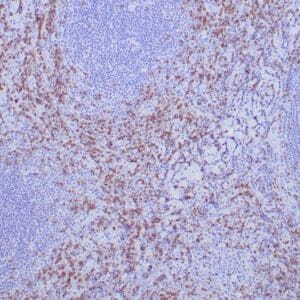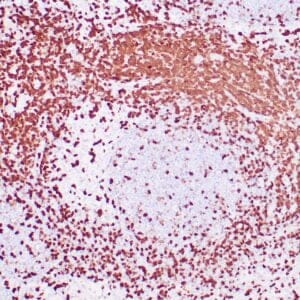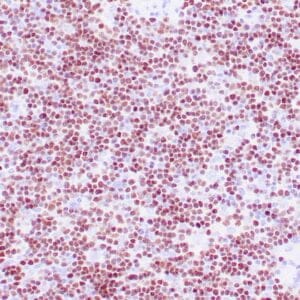| Weight | 1 lbs |
|---|---|
| Dimensions | 9 × 5 × 2 in |
| host | mouse |
| isotype | IgG |
| clonality | monoclonal |
| concentration | concentrate, predilute |
| applications | IHC |
| reactivity | human |
| available size | 0.1 mL, 0.5 mL, 1 mL concentrated, 7 mL prediluted |
rabbit anti-CD10 monoclonal antibody (ZR329) 6053
Price range: $160.00 through $528.00
Antibody summary
- Rabbit monoclonal to CD10
- Suitable for: Immunohistochemistry (formalin-fixed, paraffin-embedded tissues)
- Reacts with: Human
- Isotype:IgG
- Control: Follicular lymphoma, lymph node
- Visualization: Membrane
- 0.1, 0.5, 1.0 mL concentrated, 7 mL prediluted
rabbit anti-CD10 monoclonal antibody ZR329 6053
| target relevance |
|---|
| Protein names Neprilysin (EC 3.4.24.11) (Atriopeptidase) (Common acute lymphocytic leukemia antigen) (CALLA) (Enkephalinase) (Neutral endopeptidase 24.11) (NEP) (Neutral endopeptidase) (Skin fibroblast elastase) (SFE) (CD antigen CD10) |
| Gene names MME,MME EPN |
| Protein family Peptidase M13 family |
| Mass 85514Da |
| Function FUNCTION: Thermolysin-like specificity, but is almost confined on acting on polypeptides of up to 30 amino acids (PubMed:15283675, PubMed:6208535, PubMed:6349683, PubMed:8168535). Biologically important in the destruction of opioid peptides such as Met- and Leu-enkephalins by cleavage of a Gly-Phe bond (PubMed:17101991, PubMed:6349683). Catalyzes cleavage of bradykinin, substance P and neurotensin peptides (PubMed:6208535). Able to cleave angiotensin-1, angiotensin-2 and angiotensin 1-9 (PubMed:15283675, PubMed:6349683). Involved in the degradation of atrial natriuretic factor (ANF) and brain natriuretic factor (BNP(1-32)) (PubMed:16254193, PubMed:2531377, PubMed:2972276). Displays UV-inducible elastase activity toward skin preelastic and elastic fibers (PubMed:20876573). {ECO:0000269|PubMed:15283675, ECO:0000269|PubMed:17101991, ECO:0000269|PubMed:20876573, ECO:0000269|PubMed:2531377, ECO:0000269|PubMed:27588448, ECO:0000269|PubMed:2972276, ECO:0000269|PubMed:6208535, ECO:0000269|PubMed:6349683}. |
| Catalytic activity CATALYTIC ACTIVITY: Reaction=Preferential cleavage of polypeptides between hydrophobic residues, particularly with Phe or Tyr at P1'.; EC=3.4.24.11; Evidence={ECO:0000269|PubMed:15283675, ECO:0000269|PubMed:27588448, ECO:0000269|PubMed:6208535, ECO:0000269|PubMed:6349683, ECO:0000269|PubMed:8168535}; CATALYTIC ACTIVITY: Reaction=substance P + H2O = substance P(1-9) + L-Leu-L-Met-NH2; Xref=Rhea:RHEA:71459, ChEBI:CHEBI:15377, ChEBI:CHEBI:190692, ChEBI:CHEBI:190693, ChEBI:CHEBI:190700; Evidence={ECO:0000269|PubMed:6208535}; PhysiologicalDirection=left-to-right; Xref=Rhea:RHEA:71460; Evidence={ECO:0000269|PubMed:6208535}; CATALYTIC ACTIVITY: Reaction=substance P + H2O = substance P(1-7) + L-Phe-Gly-L-Leu-L-Met-NH2; Xref=Rhea:RHEA:71467, ChEBI:CHEBI:15377, ChEBI:CHEBI:190692, ChEBI:CHEBI:190695, ChEBI:CHEBI:190698; Evidence={ECO:0000269|PubMed:6208535}; PhysiologicalDirection=left-to-right; Xref=Rhea:RHEA:71468; Evidence={ECO:0000269|PubMed:6208535}; CATALYTIC ACTIVITY: Reaction=neurotensin + H2O = neurotensin(1-11) + L-isoleucyl-L-leucine; Xref=Rhea:RHEA:71475, ChEBI:CHEBI:15377, ChEBI:CHEBI:147362, ChEBI:CHEBI:190704, ChEBI:CHEBI:190706; Evidence={ECO:0000269|PubMed:6208535}; PhysiologicalDirection=left-to-right; Xref=Rhea:RHEA:71476; Evidence={ECO:0000269|PubMed:6208535}; CATALYTIC ACTIVITY: Reaction=neurotensin + H2O = neurotensin(1-10) + L-tyrosyl-L-isoleucyl-L-leucine; Xref=Rhea:RHEA:71479, ChEBI:CHEBI:15377, ChEBI:CHEBI:147362, ChEBI:CHEBI:190705, ChEBI:CHEBI:190707; Evidence={ECO:0000269|PubMed:6208535}; PhysiologicalDirection=left-to-right; Xref=Rhea:RHEA:71480; Evidence={ECO:0000269|PubMed:6208535}; |
| Subellular location SUBCELLULAR LOCATION: Cell membrane {ECO:0000269|PubMed:20876573}; Single-pass type II membrane protein {ECO:0000255}. |
| Post-translational modification PTM: Myristoylation is a determinant of membrane targeting. {ECO:0000269|PubMed:19756956}.; PTM: Glycosylation at Asn-628 is necessary both for surface expression and neutral endopeptidase activity. {ECO:0000269|PubMed:10669592, ECO:0000269|PubMed:12754519, ECO:0000269|PubMed:14747736, ECO:0000269|PubMed:17704566, ECO:0000269|PubMed:22766194}. |
| Involvement in disease DISEASE: Charcot-Marie-Tooth disease, axonal, 2T (CMT2T) [MIM:617017]: An axonal form of Charcot-Marie-Tooth disease, a disorder of the peripheral nervous system, characterized by progressive weakness and atrophy, initially of the peroneal muscles and later of the distal muscles of the arms. Charcot-Marie-Tooth disease is classified in two main groups on the basis of electrophysiologic properties and histopathology: primary peripheral demyelinating neuropathies (designated CMT1 when they are dominantly inherited) and primary peripheral axonal neuropathies (CMT2). Neuropathies of the CMT2 group are characterized by signs of axonal degeneration in the absence of obvious myelin alterations, normal or slightly reduced nerve conduction velocities, and progressive distal muscle weakness and atrophy. {ECO:0000269|PubMed:26991897, ECO:0000269|PubMed:27588448}. Note=The disease is caused by variants affecting the gene represented in this entry.; DISEASE: Spinocerebellar ataxia 43 (SCA43) [MIM:617018]: A form of spinocerebellar ataxia, a clinically and genetically heterogeneous group of cerebellar disorders. Patients show progressive incoordination of gait and often poor coordination of hands, speech and eye movements, due to degeneration of the cerebellum with variable involvement of the brainstem and spinal cord. SCA43 is a slowly progressive, autosomal dominant form. {ECO:0000269|PubMed:27583304}. Note=The disease is caused by variants affecting the gene represented in this entry. |
| Target Relevance information above includes information from UniProt accession: P08473 |
| The UniProt Consortium |
Data
 |
| Formalin-fixed, paraffin-embedded human liver stained with anti-CD10 antibody using peroxidase-conjugate and DAB chromogen. Note the canalicular staining of hepatocytes |
Publications
| pmid | title | authors | citation |
|---|---|---|---|
| We haven't added any publications to our database yet. | |||
Protocols
| relevant to this product |
|---|
| IHC |
Documents
| # | SDS | Certificate | |
|---|---|---|---|
| Please enter your product and batch number here to retrieve product datasheet, SDS, and QC information. | |||
Only logged in customers who have purchased this product may leave a review.















Reviews
There are no reviews yet.